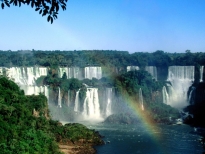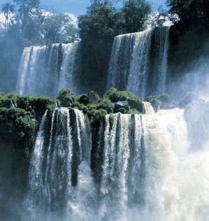 |
A memorable
experience and a spectacle of nature they are considered a wonder of the world.
These falls originated 200 thousands years ago in the place that today is known
as “the 3 frontiers” marked with stone pillars, where the Iguazú river and the
Paraná river meet. A geological fault produced on the Paraná riverbed made the
outlet of the Iguazú river become an abrupt cascade approximately 80 meters high.
From that point, where the falls originate to where the Devil’s
Throat is located today, covers 23 kilometers.
This is due to the slow process |
of erosion, however the steep drop which
defines them as waterfalls remains. This original cascade, has become the most
impressive falls of the group, The Devil’s Throat. Eighty meters high, it is
located on the principal river course. Depending on the water level, you can see
anywhere between 160 a 270 falls, that on average flow at a rate of 1500 cubic
meters of water per second. The violence of the falls produce a permanent fog,
where sunbeams form multiple rainbows of incredible beauty.
|
The waterfall system
consists of about 270 falls, with heights of up to 80
metres (though the majority of the system is at a height of 64 metres) ,
along 2.7 kilometres of the Iguazu River. The Garganta del Diablo ("Devil's
Throat"), a U shaped 150 metres wide and 700 metres long cliff, is the
most impressive of all, and marks the border between Argentina and
Brazil. Most of the falls are within Argentine territory, but from the
Brazilian side (600 metres) a more panoramic view of the Garganta del
Diablo is obtained. Many Islands split up the falls, including several
large ones. About 900 metres of the 2.7 kilometre length does not have
water flowing over it. The first European to find the falls was the
Spanish Conquistador Alvar Nunez Cabeza de Vaca, after whom one of the
falls in the Argentine side is named. |
 |
The Falls are shared by the
Iguazú National Park (Argentina) and Iguaçu National Park (Brazil). These parks
were designated UNESCO World Heritage Sites in 1984 and 1986 respectively.
The name Iguazu comes from the Guarani words y (water) and guasu (big). The
legend says that a god pretended to marry a beautiful aborigine named Naipú, who
fled with her mortal lover in a canoe. In rage, the god sliced the river
creating the waterfalls, condemning the lovers to an eternal fall.
There are two main towns on either side of the Iguazu falls; Foz do Iguaçu in
the Brazilian state of Paraná, and Puerto Iguazú in the Argentine province of
Misiones. Other important tourist attractions near the falls include the Itaipu
hydroelectric power plant, and the Jesuit Missions of the Guaranis in Argentina,
Paraguay and Brazil.
|
|